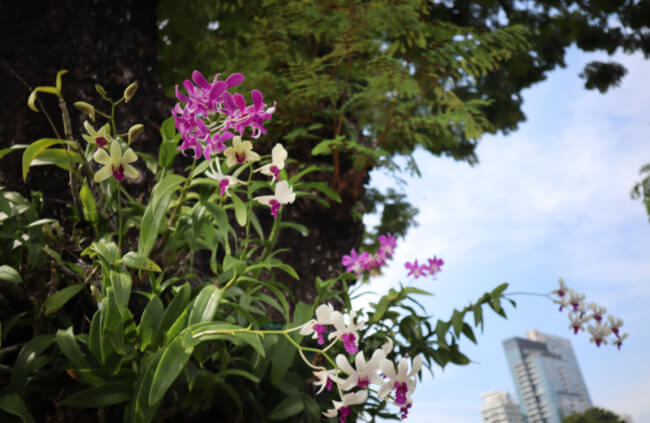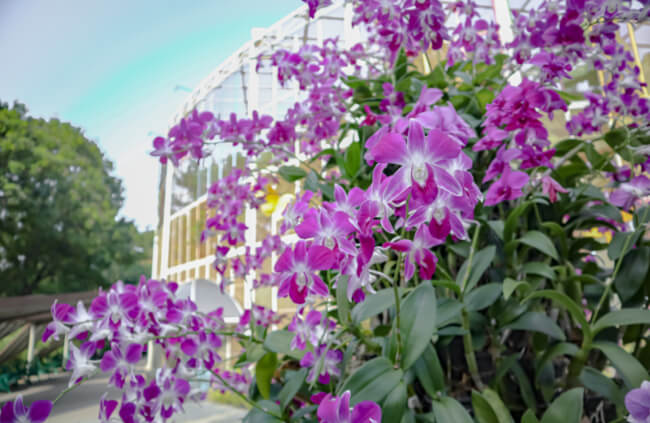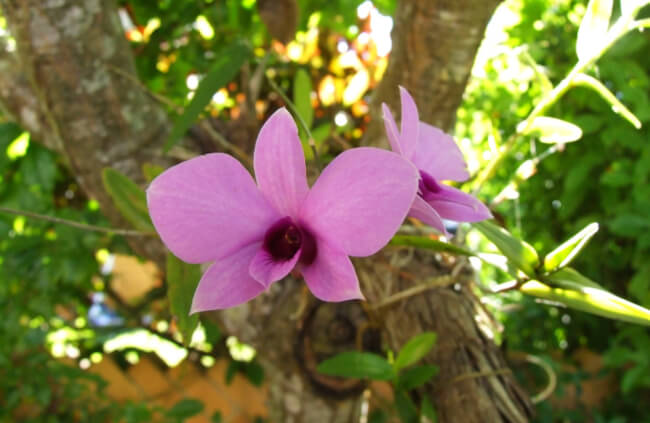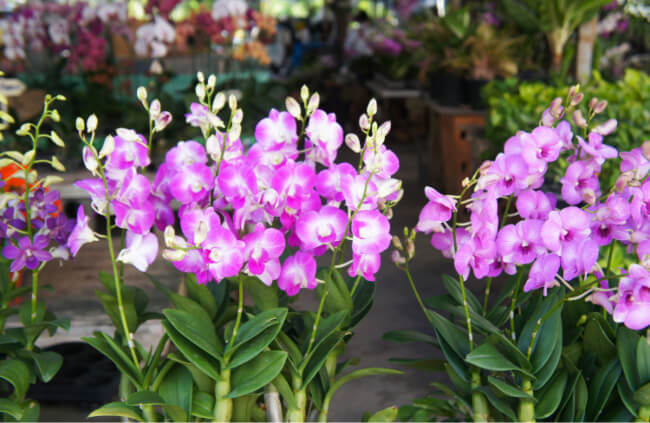Growing native orchids, for the most part, isn’t that difficult, but the same can’t be said for the Cooktown orchid. While it will grow in pretty much any crevice it finds in stone or trees in the wild, managing the right balance of tropical heat and humidity in your own garden can be tricky.
With the right knowledge though, and a few simple steps to prepare your growing medium and find the right spot for Cooktown orchids, you can grow happy, healthy native orchids with stunning purple flowers and gorgeously structural stems.
In this guide we’ll share everything you need to know about growing Cooktown orchids, propagating them, and caring for mature plants as they develop.
More...

Family: | Orchidaceae |
|---|---|
Genus: | Dendrobium |
Species: | D. bigibbum var. superbum |
Origin: | North Queensland and New Guinea |
Common Names: | Cooktown orchid |
Location: | Indoor or greenhouse |
Type: | Epiphytic or lithophytic perennial |
Growth: | Up to 1.2m tall |
Sun requirements: | Light shade |
Foliage Colour: | Green |
Flower Colour: | Purple |
Flowering: | Summer (can flower all year indoors) |
Fruit: | None |
Maintenance level: | Medium-High |
Poisonous for pets: | Non-toxic to cats and dogs |
Getting to Know Cooktown Orchids
Cooktown orchids are one of the most wonderful native flowers we have in Australia. They grow as epiphytes and lithophytes in the wild, but in cultivation can be grown on standard orchid growing mediums with a few small tweaks.
Cooktown orchids reach a maximum height of 1.2m in the wild, but indoors or in outdoor cultivation rarely grow taller than 60cm, making them a great compact option for bright bathrooms, or reasonably humid indoor spaces.

Natural Habitat of Dendrobium bigibbum
Cooktown orchids are native to northern Queensland and parts of New Guinea. They thrive in tropical conditions where they benefit from bright, humid conditions with dappled shade from the canopies of trees they grow beneath.
That’s the simple version. In truth, Cooktown orchids can be found growing anywhere from cliff faces to bogs, and are most commonly found growing on the side of mature trees thanks to seed dispersal on the wind. In all scenarios they develop to maturity best with some shade and good humidity.
What is the difference between epiphytic and lithophytic?
Epiphytic plants grow on the sides of trees, generally using roots to anchor them to mature bark. Lithophytic plants do the same, but on rock and stock.
In both cases, their roots feed from moisture from rainfall and humidity, not as parasites on the tree. The most famous example are bromeliads that, like orchids, can grow as epiphytes and lithophytes, feeding mostly from reservoirs in the plant’s centre.
Orchids feed more effectively from humidity, and require specialist plant foods that their roots can take up without being submerged for too long.
How to Grow Cooktown Orchids
It is entirely possible to grow Cooktown orchids in every part of Australia, but they do require warm conditions with humidity at around 75% and some dappled or filtered shade from the afternoon sun.
In terms of growing medium, they can be grown on boards or cork, or in an orchid potting mix, but for the best results follow our guide below for slight tweaks you can make to improve the health of your Cooktown orchids.

Shade and Light Conditions
Cooktown orchids need bright light, and do best with around four hours of direct morning light, and bright but shaded afternoon conditions. Indoors, or in a greenhouse, the easiest way to achieve this is to position them within about 1 m of an east-facing window.
To provide shade, it’s worth getting to know how light actually works. A clear window filters out all UV-B and UV-C light, but lets 100% of UV-A light through. So even a south facing window provides some shade. However, windows tend to amplify heat, so avoid any window that receives full afternoon sun.


Get Your Free Guide:
Master Growing Australian Natives eBook
A Must Have Complete Guide for Every Australian Garden
Get Your Free Guide:
Master Growing Australian Natives eBook
A Must Have Complete Guide for Every Australian Garden
Water and Humidity
Cooktown orchids need a base humidity of 75%, 70% is ok. In winter, if they fade and stop actively flowering, drop humidity down to around 65%, keeping them just moist enough so they stay reasonably rigid.
Whatever time of year your Cooktown orchids stop flowering though, if you grow them indoors, treat that as their winter. Increase their shade slightly, and drop humidity to 65% to support their natural dormancy.
Soil and Growing Medium
You can grow most orchids in either bark or perlite. A mix of the two can work well too. However, we’ve found that Cooktown orchids prefer a bark growing medium with charcoal.
Perlite, while hospitable to Cooktown orchids, doesn’t hold nutrients effectively, and stops you from keeping an eye on your orchid roots.
Using a bark and charcoal mix (I use a standard fir bark, with flakes of charcoal mixed through. The charcoal holds moisture and nutrients, but also kills bacteria, making a much friendlier growing medium for these often picky orchids.
Growing Cooktown Orchids Indoors
Cooktown orchids grow best indoors. Unless you live in tropical or subtropical parts of Australia there is very, very little chance that you’ll be able to successfully grow Cooktown orchids outdoors without a glasshouse or, at the very least, a glass-covered pergola.
Using the guide to growing medium, light and humidity above, find a suitable spot in your house for your Cooktown orchid. As I’ve mentioned, the best spot for this will be within 1 m of an east-facing bathroom window.
In the absences of that, regular misting, or adding a humidifier to your room will support Cooktown orchid growth in any part of the house, and provided your orchid gets around four hours of direct morning sun, and bright but dappled-shade conditions through the afternoon, it should be quite happy.
How to Grow Cooktown Orchids Outdoors
Growing Cooktown orchids is a tricky business, simply because you are much, much less in control. If you have a greenhouse, lean-to, conservatory or covered pergola that holds the heat (even through winter) that’s your best bet for growing Cooktown orchids outdoors.
Again, the planting medium and growing conditions are the same as anywhere else, but positioning can be a little bit more creative. If, for example, you have a brick or stone wall. You can, with some effort, grow Cooktown orchids successfully as natural lithophytes.
If you have a very bright, warm spot, with good humidity, you can just bout grow Cooktown orchids on the trunks or branches of deciduous trees too
To get the same effect in more temperate parts of Australia, grow Cooktown orchids on cork boards, or in hanging orchid pots under cover.
Propagating Cooktown Orchids from Cuttings

Orchids have thick, fleshy roots, and can often create natural divisions, which are simple to prick out using a pencil or tweezers. New Cooktown orchids are fairly obvious, either as aerial growths, which can be pruned off and potted up as if planting a young orchid, or by removing new young rosettes from around the base of the plant, which pull up with young root systems attached.
In both cases, use a fine, bark-based growing medium to start them off, find them a bright, warm and humid spot, and mist them as often as they need to retain a good moisture level in their potting medium.
Within a couple of weeks, they should have rooted well, and can be easily potted into a proper mix of bark and charcoal to develop.
Cooktown Orchid Care Tips
Once you’ve got your Cooktown orchid in a good spot, where it’s growing happily and flowering, everything else is about maintenance; maintaining nutrients; maintaining moisture; maintaining humidity.
If you can get it right, it’s a simple rhythm that you’ll just naturally swing into. So, Cooktown orchids might be more time consuming than many other plants, but it’s actually pretty easy when you get used to it.
Feeding Cooktown Orchids
There are two ways to feed orchids, and Cooktown orchids are no different. You can feed them the right way, or the easy way. Frankly, both work just as well as each other.
The right way, according to most collectors, is to lightly dilute orchid fertiliser at ¼ of the recommended strength, in their water, every week. This means you can adjust and react to their feeding more naturally.
The easy way, and my favourite, is to feed your orchids with a slow release orchid fertiliser when you first pot them up, and then again just as they begin to flower. The downside of this is that once you’ve fed your orchids, it’s hard to amend it if there’s too much feed. The upside is that all you need to do is water once a week.
Moisture requirements
Water your Cooktown orchids once a week. That’s pretty much it. Obviously, if your orchids are in very bright conditions, or humidity is lower than 70-75%, then you’ll need to water more often.
If your humidity is too high, there’s a chance your orchids could retain moisture around their roots for longer. However, it’s worth draining any water around their roots, and rinsing the bark if that’s the case, because it’s better that they have access to fresh water than old water.
Repotting Cooktown Orchids
When you first bring a Cooktown orchid home, it should be repotted. 99% of Cooktown orchids sold are grown in a single pot until they are sold, by which time, their roots have completely filled the container.
Pot your orchid on any time you see roots starting to swirl into the corners of their containers (once every two years on average).
Shake off any old potting medium, and replace it entirely with new. If there is some potting medium held inside a tangle of roots, you can leave it if it’s in good condition, but if you can shake it loose, do so.
After repotting, mist your Cooktown orchids once a week as an absolute minimum, and make sure their roots are reasonably moist until you see new growth.
Pruning Cooktown Orchids
There are two types of orchid pruning; routine pruning, and damage pruning.
Routine pruning for orchids is a basic, but regular occurrence. Essentially, when Cooktown orchid flowers, that flower spike will die back, and be replaced with a new one for the next set of flowers. Once flowers are finished, simply cut that flower stem right back to the base of the plant to tidy it up.
Pruning out damaged sections of orchids can include pruning damaged leaves, or discoloured leaves that might be a sign of fungal or bacterial infections, or pruning any roots that have discoloured.
Brown or black orchid roots are doing no good for the plant, and may actually be harming it. To prune out roots, shake away any growing medium, and cut roots back using sterilised secateurs or pruning scissors. Dip them in bleach or boiling water between each cut.
(Check out our product reviews and top picks for the best secateurs available online.)
Cooktown Orchid Pests and Diseases
Cooktown orchids are basically pest and disease free, but when grown in a greenhouse, spider mites can often be found around their foliage. If this happens, try to wipe them off with a wet paper towel. It’s unlikely they’ll come back.
If you don’t give Cooktown orchids enough light, and pair that with too much humidity, their roots can turn brown and mushy, which is a simple reaction to bacteria and fungus in the water. Prune out these roots, and clean or replace the growing medium. After a few weeks, your Cooktown orchids should recover well.
Frequently Asked Questions About Cooktown Orchids

Is the Cooktown orchid rare?
Cooktown orchids are quite easy to find as houseplants in Australia, but they are sadly rare in the wild as a direct result of human activity, including plant and seed collection and habitat loss due to intensive agriculture and climate change.
How often does the Cooktown orchid flower?
The Cooktown orchid can flower several times a year indoors or under glass in a greenhouse. In the wild, Cooktown orchids will flower for about a month in early summer, triggered by a mixture of brighter mornings and warmer afternoons.
How do you look after a Cooktown orchid?
The easiest way to look after a Cooktown orchid is to add a humidifier to your room. Maintain humidity at around 70-75%, and find a bright spot with direct morning sun, and your Cooktown orchid should grow happily for years to come.
What is the lifespan of a Cooktown orchid?
Cooktown orchids can live for as long as you keep them happy. In the wild, they tend to have lifespans of around 20 years before each plant outgrows in an anchored growing spot, but by that time it will have re-seeded itself to nearby trees and stone crevices.
Is my Cooktown orchid dead if the flowers fall off?
Orchids all wilt after flowering, but the leaves should remain rigid, so no, your Cooktown orchid isn’t dead or even unhappy if its flower stems fall off and wilt after flowering.
Should you deadhead Cooktown orchids?
As soon as your Cooktown orchid flower spike has stopped flowering, cut it right back to the crown. If you’re lucky, this will result in a whole new flowering stem. If you’re unlucky, your orchid will look neater as a result, so it's win-win.
How do you get Cooktown orchids to bloom again?
Cooktown orchids bloom again when they are triggered by increased light, heat and humidity, following a drop in all three. You can move your orchid to a cooler, drier spot for a couple of weeks after flowering has finished to trigger a new flush of growth. It won’t work 10% of the time, but we have good results with this method.
Wrapping Up Our Cooktown Orchids Growing and Care Guide
Growing Cooktown orchids is the legacy of a generation of excessive plant collections and plant explorers who decimated natural resources, but it’s also a way to make sure that those species are never lost.
So, while it’s a contradiction, growing Cooktown orchids today, helps to maintain one of Australia’s finest native plants, and helps to cement the future of these species against any future habitat loss.
With a few simple tweaks to your usual orchid growing set up, you can keep Cooktown orchids happy for many, many, years and they will grow well wherever you are in Australia.
Published on June 28, 2023 by Lorri Hopkins
Last Updated on January 21, 2025




